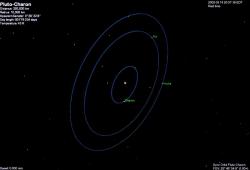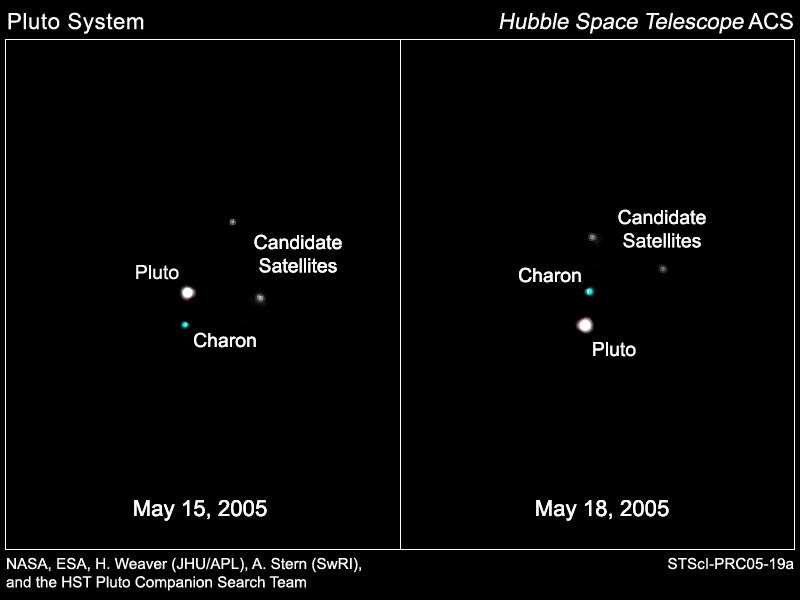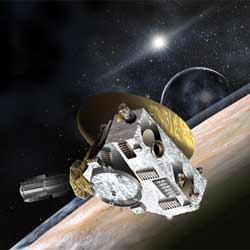How many moons does Pluto have? The mini-moons of Pluto, Nix and Hydra, were discovered in 2005 (but named in 2006) during an observation campaign by the Hubble Space Telescope. The discovery of these mini-moons increase the number of natural satellites orbiting Pluto to three (including larger moon Charon). But where did these satellites come from? The current accepted theory on the formation on the large moon, Charon, is much like the theory supporting the creation of Earth’s Moon. It is thought that a large impact between two Large Kuiper Belt Objects chipped Charon away from a proto-Pluto, putting the chunk of Pluto mass into orbit. Over the years, tidal forces slowed the pair and Charon was allowed to settle into its present-day orbit. Recent theory suggests that Nix and Hydra are a by product of this collision, merely shattered fragments of the huge impact. But there are problems with this idea. Could Nix and Hydra have come from somewhere other than the Pluto-Charon impact?

The small moons that orbit the Large Kuiper Belt Object (formerly classified as a planet) can be found about 48,700 kilometers and 64,800 kilometers from the surface of Pluto. The closest moon is called Nix and the farthest, Hydra. Nix has an orbital resonance of 4:1 with Charons orbit and the larger moon Hydra has a resonance of 6:1 (i.e. Nix will orbit Pluto once for every four of Charons orbits; Hydra will orbit Pluto once for every six of Charons orbits).
The reasons behind these mini-moon orbits are only just beginning to be understood, but it is known that their resonances with Charons orbit is rooted way back during the Pluto-system evolution. If we assume Hydra and Nix were formed from a massive Kuiper Belt Object collision, the easiest explanation is to assume they are whole fragments from the impact caught in the gravity of the Pluto-Charon system. However, due to the highly eccentric orbits that would have resulted from this collision, it is not possible that the two little moons could have evolved into a near-circular orbit, in near-corotational resonance with Charon.
So, could it be possible that the moons may have formed from the dust and debris resulting from the initial collision? If there was enough material produced, and if the material collided frequently, then perhaps Nix and Hydra were born from a cold disk of debris (rather than being whole pieces of rock), eventually coalescing and forming sizeable rocky moons. As there may have been a disk of debris, collisions with the orbiting Nix and Hydra would have also reduced any eccentricity in their orbits.
But there is a big problem with this theory. From impact simulations, the post-impact disk of debris surrounding Pluto would have been very compact. The disk could not have reached as far as the present-day orbits of the moons.
One more theory suggests that perhaps the moons were created in a post-impact disk, but very close to Pluto, and then through gravitational interactions with Charon, the orbits of Nix and Hydra were pulled outward, allowing them to orbit far from the Pluto-Charon post-impact disk. According to recent computer simulations, this doesn’t seem to be possible either.
To find an answer, work by Yoram Lithwick and Yanqin Wu (University of Toronto) suggest we must look beyond the Pluto-Charon system for a source of material for Nix and Hydra. From simulations, the above theories on the creation of the small moons being started by material ejected from a large collision between two Large Kuiper Belt Objects (creating Pluto and Charon) are extremely problematic. They do not correctly answer how the highly eccentric orbits Nix and Hydra would have from a collision could evolve into the near-circular ones they have today.
Lithwick and Wu go on to say that the circular, corotational resonant orbits of the two moons could be created from a Plutocentric disk of small bits of rock scooped up during Pluto’s orbit around the Sun. Therefore Nix and Hydra may have been formed from the rocky debris left over from the development of the Solar System, and not from a collision event creating Charon. This may hold true for the countless other Kuiper Belt Objects in orbit in the far reaches of the Solar System, no impact is necessary for the creation of the tiny moons now thought to be their satellites.
It is hoped that the New Horizons mission (launched January 21st, 2006) to the far reaches of the Solar System will reveal some of the questions that remain unanswered in the depths of our mysterious Kuiper Belt. Hopefully we will also find out whether Nix and Hydra are children of Pluto and Charon… or whether they were adopted.
Source: arXiv


